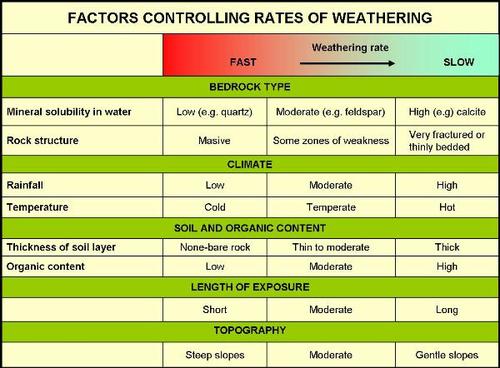Mountains Breakup
Weathering and erosion: Mountains breakup
Major geologic processes in the rock cycle and in Earth system are erosion and weathering, both in some instances are inseparable and often associated with integrated uplift and exhumation.
Weathering
Is a destructive process in which physical disintegration and chemical decomposition produce the breaking down of rock and minerals at or near earth’s surface by exposure to atmospheric agents.
In the process of weathering no movement is involve.
All rocks type weather, but the manner and rate of their weathering depends on the factors that control the fragmentation and decay of rocks.
The factors that control rock weathering are:
a) Properties of parent rock: different minerals weather at different rates, also rock’s structures affects its susceptibility to cracking and fragmentation.
b) Climate: High temperature and heavy rainfall increases the growth rate of organism and thus promotes chemical weathering. In cold climates, water can´t dissolve minerals because it is frozen, whereas in arid regions water is relatively unavailable. In both cases, chemical weathering proceeds slowly. Climates that minimize chemical weathering may enhance physical weathering.
c) Presence or absence of soil: Soil retains moisture, host vegetation and organism, all which favors the formation of acidic environment that promotes chemical weathering. Plant roots and organism may promote physical weathering by tunneling or creating fractures in the bedrock.
d) Length of exposure: Is the time the rock is exposed to the atmospheric agents. Given enough time, even a resistant rock will ultimately decay.
e) Topography: Areas with low topographic elevations are more suciptible to weathering.
